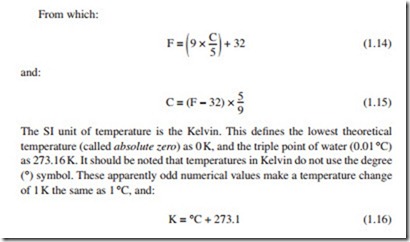temperature
Fluid behavior is determined to some extent by its temperature. A later section discusses the relationship between pressure and temperature in a gas.
temperature scales
A temperature scale is established by choosing two observable physical effects which are dependent upon temperature and assigning numerical values to them. The Fahrenheit and Celsius (previously known as Centigrade) scales use the freezing and boiling points of water as the two reference points:
The Celsius scale is most widely used in industry, but the Kelvin scale is important in determining the changes in gas pressure or volume with temperature.
Related posts:
System and process requirements:Supply and demand controlled systems
Engineering Data:Standards and publications
Applications on pneumatic:Contractors tools
Applications on pneumatic:Mining and quarrying equipment.
THE COMPRESSOR:COMPRESSOR CLASSIFICATION AND SELECTION.
VALVES:DIRECTIONAL CONTROL VALVES
Moisture and condensation:Relative humidity and Psychrometric chart.
Low pressure and vacuum:Suction nozzles and Feed rate control.
ACTUATORS:Trunnion Mount and Clevis Mount
HYDRAULIC FLUIDS:Density and Specific Gravity
Fluid flow.
THE SECOND LA W OF THERMODYNAMICS:THE CARNOT PRINCIPLES
ENTROPY:THE ENTROPY CHANGE OF IDEAL GASES
INTRODUCTION TO FLUID MECHANICS:CLASSIFICATION OF FLUID FLOWS
HEAT EXCHANGERS:THE EFFECTIVENESS–NTU METHOD

